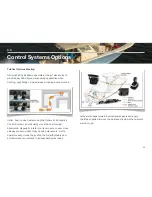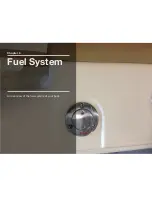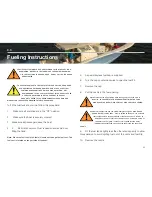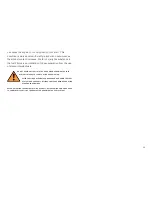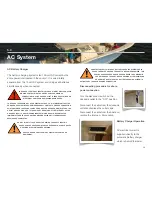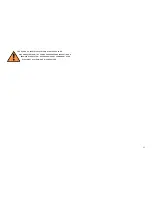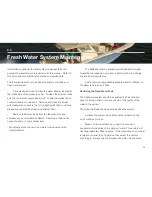
each battery and direct the available current to the batteries that
require charging. When one or both engines are started, the
engine alternator(s) start to recharge the batteries. This charging
current passes through the VSR and the engine isolator charging
circuit. These circuits sense the charge and it is split between the
batteries, with the lowest battery receiving the most charge.
When the engines are turned o
ff
all charging stops and all sensing
circuits turn o
ff
thereby automatically isolating the batteries from
one another. The engine isolator charging circuits from each
engine have a 100 amp breaker which is located on the port and
starboard walls of the aft bilge. It is recommended to check these
breakers periodically and make sure they are not tripped. When in
port or at anchor the switch that supplies the engines should be
o
ff
. This will keep the engine starting batteries in reserve for
starting the engines. All battery switches should be in the “OFF”
position when leaving the boat unattended.
Note: Current is supplied to the automatic float switches for the bilge pumps
when the batteries are connected, even if the battery switch is o
ff
.
12-Volt Accessory Switch Panels
The main accessory switch panels are located at the helm and on
the hard top. The fuses that protect the accessories are located
in the CZone modules. See CZone section for exact location of
fuses.
The following is a description of the accessories controlled by
the hardtop accessory switch panel:
FWD Spreader
Activates the forward spreader light on the hard top.
AFT Spreader
Activates the aft spreader light on the hard top.
Hardtop Lt
Activates the hardtop light.
43
Summary of Contents for 320 LXF
Page 1: ...320 LXF Scout Boats OWNER MANUAL ...
Page 2: ...Chapter 1 Owner s Information Warranty Certification and Boat Information ...
Page 11: ...Chapter 2 Propulsion A guide to your boat s propulsion system ...
Page 32: ...Chapter 4 Fuel System An overview of the fuel system of your boat ...
Page 40: ...Chapter 5 Electrical System An overview of the electrical system of your boat ...
Page 54: ...Chapter 6 Fresh Water System An overview of the fresh water system of your boat ...
Page 59: ...Chapter 7 Raw Water System An overview of the raw water system of your boat ...
Page 65: ...Chapter 8 Drainage System An overview of the drainage system of your boat ...
Page 70: ...Chapter 9 Ventilation System An overview of the ventilation system of your boat ...
Page 73: ...Chapter 10 Exterior Equipment An overview of the exterior equipment on your boat ...
Page 83: ...Chapter 11 Interior Equipment An overview of the interior equipment on your boat ...
Page 88: ...Chapter 12 Safety Equipment An overview of the safety equipment on your boat ...
Page 99: ...Chapter 13 Operation A general guide to operating your boat ...
Page 124: ...Chapter 14 Routine Maintenance A guide to keeping your boat running in good condition ...
Page 147: ...Chapter 16 Appendix Reference documents logs and schematics for your boat ...
Page 154: ...153 ...
Page 155: ...154 ...
Page 156: ...155 ...
Page 157: ...156 ...
Page 159: ...158 ...
Page 160: ...159 ...
Page 162: ...161 ...


